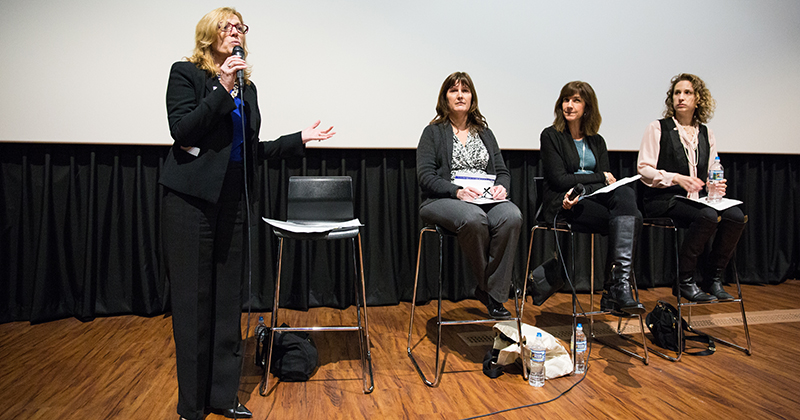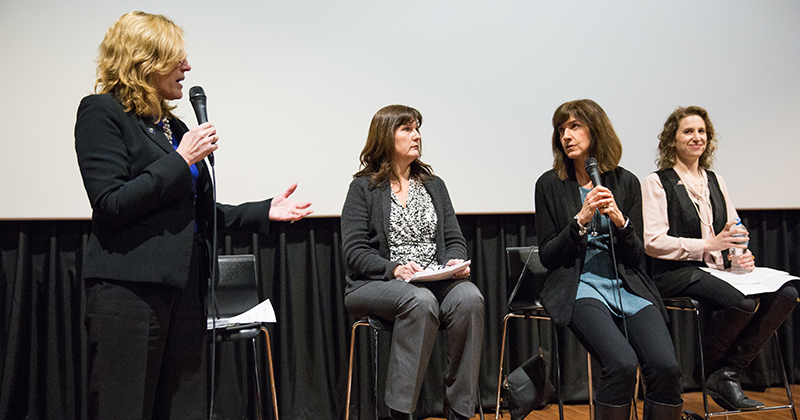

Lecture and movie focus on eating disorders
Photos by Ashley Barnas February 06, 2018
College of Health Sciences hosts eating disorders movie night for the community
The University of Delaware College of Health Sciences (CHS) invited the local community to Main Street Movies 5 in Newark, Delaware, for a unique discussion on anorexia nervosa, bulimia nervosa, and binge-eating disorders.
“Lecture and a Movie: Eating Disorders” featured a discussion with UD eating disorders experts; the theatre then showed To the Bone, a Netflix film chronicling a young woman’s struggle with anorexia nervosa.
The evening -- with moderator Rita Landgraf, professor of practice and distinguished health and social services administrator in CHS, and panelists Carly Pacanowski, assistant professor of behavioral health and nutrition (BHAN)], Sharon Collison, instructor in BHAN and part of the Nutrition Center at STAR Health, and Michelle Juarez-Huffaker, psychologist II in UD’s Center for Counseling and Student Development -- featured discussion of evidenced-based research and clinical best practices, as well as a critique of the film and questions from the audience. The group stressed that you can’t tell if someone is struggling based on appearance alone.
“Eating disordered behaviors cause significant bodily harm and can be potentially life threatening, so it’s important for people to be aware of signs and symptoms to ensure loved ones get professional help as quickly as possible,” explained Collison, a registered dietitian. “A multidisciplinary approach to treatment is recommended that includes a psychotherapist, a registered dietitian and a physician who are trained and experienced to treat this illness.”
“As Delaware’s former cabinet secretary of health and social services, I witnessed firsthand how critically important outreach and education on key health issues are to our community,” Landgraf said. “These events provide a great venue to bring key topics, such as eating disorders, to the ground in a user-friendly way that combines awareness and science.”
Local parents, school employees and health professionals comprised the majority of those in the theatre.
“What a great opportunity to hear professionals speak on eating disorders from a variety of different angles,” said school nurse and event attendee Marguerite Diehl. “[The panelists’] educational backgrounds and clinical expertise provided much background knowledge regarding the complexity of multiple eating disorders.”
CHS also set up tables in the theatre lobby, which featured UD and external resources on eating disorders.
Panelist Pacanowski pointed out that undergraduates are particularly vulnerable.
“Disordered eating behaviors – like exercising to specifically counteract intake, vomiting or using laxatives – can be a precursor to eating disorders and are very common in college population. Estimates show that between 25 and 33 percent exhibit disordered eating behaviors,” the BHAN researcher explained.
About eating disorders
Eating disorders are psychiatric illnesses, including anorexia nervosa, bulimia nervosa and binge-eating disorders. These illnesses have one of the highest mortality rates of all psychiatric illnesses. The diseases are complex and often start with disordered eating behaviors (such as strict and rigid dieting for weight loss), vomiting or exercising specifically to counteract calories in meals and a fear of fatness. The National Eating Disorders Association (NEDA) estimates that 20 million women and 10 million men in America will have an eating disorder at some point in their lives.
Eating disorders have some of the highest mortality rates of all psychiatric illnesses; individuals with anorexia nervosa in particular have a higher risk of death than individuals with schizophrenia, depression, bipolar, acute and transient psychotic disorders, according to World Psychiatry 2014.
Disordered eating is generally defined as when a person engages in abnormal eating habits on a regular basis. Disordered eaters can eventually develop eating disorders. The difference is in the frequency and severity of the person's behavior, and the corresponding stress.
Contact Us
Have a UDaily story idea?
Contact us at ocm@udel.edu
Members of the press
Contact us at 302-831-NEWS or visit the Media Relations website






